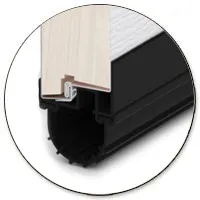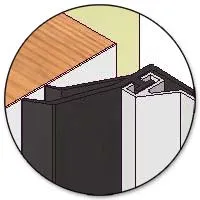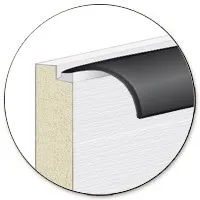Garaga commercial garage doors thermal break features
What is a thermal break and why is it important?
Here is what you need to know:
|
1-The type of seal between the sections: triple InterlockTM PVC molding mechanically linking the front and back metal sheets while preventing any contact between them which eliminates any thermal transfer (fig. #1). Also the air infiltration rating is 0.033 litre/sec. per meter (ASTM-E283) of joint between the panels. (Note that this feature is not available on our G-8000 and G-8500 models). |

|
|
2- Wood end blocks perform a dual purpose: they insure a thermal break while providing better fastening of the end hinges which are attached to a 1 ¾"-thick piece of solid wood with lag screws (fig. #2). Standard with other manufacturers for end hinge fastening is a self-tapping screw going through a steel end cap, door sheet and hinge strip for a total thickness of approximately 0.11" (2.7 mm), thus engaging only about 2 or 3 threads (fig. #3). Note: a steel end cap allows thermal transfer, thus reducing the advertised R-value. |


|
|
3- Bottom weather seal: made of TPE (thermoplastic Elastomer). "U"-shaped mounted on an extruded PVC retainer (fig. #4). The high rubber content allows the seal to remain flexible during cold weather (-62°F, -52°C) maintaining the seal unlike other products that have a low rubber content which can harden in cold weather therefore causing seal failure, cracking and splitting over time. |

|
|
4- Door frame weather seal: double-lipped seal overlapping the door by 1.5 inch (38 mm) (fig. #5). The aluminum extrusion on which the double-lipped seal is mounted is reinforced. (Note: there are many ways to install the frame weather seals on the inside of the door frame to protect them in high traffic areas. Contact our technical service for more information.) |

|
|
5- Top panel weather seal: Garaga offers an optional 2 ½" (64 mm) weather seal that can be installed on the top panel (fig. #6), which provides extra weather tightness. |

|
The advertised R-value (R-16) of a sectional door means very little if the door does not have a complete thermal break system and a proper weather seal system around all four sides of the door and between the door sections. Without these features, wind, heat and cold will make their way around the door and between the sections thus greatly reducing the R-value of the door system. Save "real" energy !
Document to download: Thermal Break PDF

